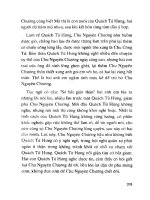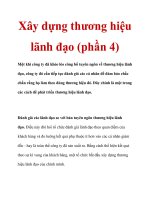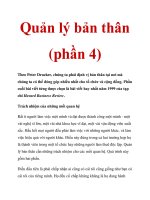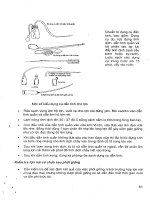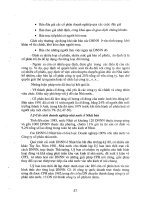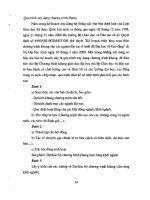CORPORATE AFTERSHOCK 2 PHẦN 4 potx
Bạn đang xem bản rút gọn của tài liệu. Xem và tải ngay bản đầy đủ của tài liệu tại đây (183.43 KB, 17 trang )
192 STRUCTURED FINANCE AFTER ENRON
ad
ditional regulatory scrutiny have not been justified, and even if it turns
out that Enron did abuse prepaids, that fact alone should not stop other
firms from making appropriate use of these products, of which there are
many. We urge regulators to move forward with caution, lest a wide range
of beneficial activities be penalized for the sins of only one abuser. We
also strongly encourage firms not to shy away from these valuable tools
for fear of “guilt by Enron association.” With proper attention to struc-
turing, disclosure, and accounting, firms using prepaids have nothing for
which to apologize.
NOTES
1. In cash-settled forwards, the cash payment obligations of the long and short
are generally netted into a single payment.
2. To see this, simply imagine that the long in a physically settled forward im-
mediately sells the 1,000 bbls of oil on the spot market at the prevailing spot
price. The net proceeds from this are identical to a cash-settled contract in
which the payment to the long is based directly on the spot price.
3.
All of our discussions of “economic equivalence” are meant to apply to
the marginal firm in equilibrium. As in many other situations in applied
price theory, inframarginal firms may face a different opportunity set in
the short run. See the discussion by Culp and Hanke in Chapter 1.
4. This does assume, of course, the usual asset pricing assumptions, including
perfect capital markets and symmetric information.
5. As Culp and Miller (1995a) explain, the long cannot escape the cost of phys-
ical storage either by synthetically storing with a forward contract.
6. The reason for the significant public information on Mahonia pertains to a
lawsuit filed by JP Morgan Chase against the insurance companies that pro-
vided Enron with surety bonds to be posted with Mahonia as guarantees of
performance on their prepaid contracts. Culp discusses this lawsuit in more
detail in Chapter 13.
193
10
ACCOUNTING AND
DISCLOSURE ISSUES IN
STRUCTURED FINANCE
K
EITH
A. B
OCKUS
, W. D
ANA
N
ORTHCUT
,
AND
M
ARK
E. Z
MIJEWSKI
N
ot many people are interested in the debates about the rules that
managers must use to prepare a company’s financial statements
(generally accepted accounting principles [GAAP]). Most people
view those debates as esoteric and irrelevant. Thus, it is no surprise that
these debates typically take place only within the confines of the private
and governmental regulatory bodies that set the standards for financial
reporting.
1
However, because of Enron’s quick loss of billions of dollars of
market capitalization and its bankruptcy, these debates gained wide-
spread public interest, and accounting rules and their regulation fell into
the center of the political arena.
2
Is Enron’s demise an example of the failure of accounting rules? Are
the accounting rules inadequate? While we do not have the answers to these
questions, in this chapter we contribute to this debate by describing and an-
alyzing the accounting rules in the Enron controversy. Specifically, we dis-
cuss the accounting rules for consolidation of special purpose entities
(SPEs) and how to account for a series of prepaid purchase transactions
that are possibly linked or related, which, if treated as one transaction, are
the equivalent to a loan (prepaids).
On November 8, 2001, less than a month before it declared bankruptcy,
Enron announced that it was restating its financial statements because of
accounting errors, reflecting its conclusion that three SPEs (Chewco, JEDI,
and LJM1) did not meet certain accounting requirements and should have
been consolidated (Enron, 2001). The retroactive con
solidation resulted
194 STRUCTURED FINANCE AFTER ENRON
in a “massive” reduction in Enron’s reported net income and a “massive”
increase in its reported debt (Powers et al., 2002).
By that time, Enron had also received about $15 billion in cash pre-
payments from JP Morgan Chase and Citigroup that were booked against
future oil and gas deliveries (see Chapter 9). In certain instances, the
cash prepayments and future oil and gas deliveries were apparently
booked as a series of transactions through SPE structures. These SPE
structures and related transactions now have been alleged to be nothing
more than wash trades, where only cash (and no energy) changes hands
and thus potentially represented “bank debt in disguise.”
In this chapter, we review and discuss how the accounting and disclo-
sure of SPEs and related structured finance vehicles are highlighted by the
controversy surrounding the failure of Enron.
3
The primary issue with re-
spect to consolidation arises when a company’s involvement with an SPE
requires it to include the SPE’s assets and liabilities in its consolidated fi-
nancial statements.
4
Accordingly, the next section of this chapter summa-
rizes the accounting and disclosure of issues pertaining to SPEs. A
subsequent section then relates those broad issues to the two alleged
abuses of accounting and disclosure policy by Enron. A final section offers
a brief summary and concludes with some important public policy lessons.
CONSOLIDATION OF SPECIAL PURPOSE ENTITIES
In January 2003, the Financial Accounting Standards Board (FASB) is-
sued FASB Interpretation No. 46, Consolidation of Variable Interest Entities,
an Interpretation of ARB No. 51 (FASB, 2003), which is the new guidance re-
lated to the consolidation of SPEs. The objective of the interpretation “is
not to restrict the use of variable interest entities but to improve financial
reporting by enterprises involved with variable interest entities.”
Before turning to the current authoritative guidance specific to SPEs
leading up to the new FASB interpretation, we first summarize account-
ing standards related to the broader topic of consolidation including full
consolidation and “one-line” consolidation. These broader standards deal
with only the general case of consolidation and do not deal with the spe-
cific case of SPE consolidation.
Full Consolidation
ARB 51 (American Institute of Certified Public Accountants [AICPA],
1959), as amended by FAS 94 (FASB, 1987), provides the primary guid-
ance for full consolidation procedures. Fully consolidated financial state-
ments represent the financial position and results of operations and cash
ACCOUNTING AND DISCLOSURE ISSUES 195
flows for a single entity, although multiple legal entities may be included.
All components of the parent’s and subsidiary’s assets, liabilities, rev-
enues, expenses, and cash flows are combined. Consolidation must be
used in substantially all cases where the parent controls, either directly or
indirectly, 50 percent or more of the voting interest of a subsidiary. Con-
solidation should not be used when the parent’s control is temporary or
significant doubt exists concerning the ability of the parent to control the
subsidiary (e.g., the subsidiary is in legal reorganization or bankruptcy).
FAS 94 expanded the consolidation rules to include all majority-owned
subsidiaries, for example, finance subsidiaries of manufacturing entities
that were previously not consolidated.
One-Line Consolidation
For investments where the parent has significant influence with an entity
but not control, APB Opinion No. 18 (AICPA, 1971) requires companies
to use the equity method of accounting. Significant influence is gener-
ally defined as voting interests between 20 percent and 50 percent. The eq-
uity method can be thought of as a one-line consolidation because the
investor’s share of earnings from the investment is reported as a single
amount in the investor’s income statement. The original investment is
recorded at cost as an asset on the balance sheet and is adjusted periodi-
cally to recognize the investor’s share of earnings. Components of the in-
vestee’s financial statements are not combined with the components of
the investor’s financial statements.
SPE Consolidation
The direct authoritative guidance leading up to FASB’s new interpreta-
tion on the consolidation of SPEs has beginnings with accounting for
the extinguishment of debt (FAS 76) (FASB, 1983a) and the transfer of
receivables with recourse (FAS 77) (FASB, 1983b). FAS 76 provided that
debt may be accounted for as extinguished if assets placed in trust out-
side the debtor’s control were sufficient to satisfy the debt (i.e., in sub-
stance defeasance). FAS 77 permitted the transfer of receivables with
recourse to be treated as a sale under certain conditions, including the
seller’s surrender of control of the receivables. The provisions of both
FAS 76 and FAS 77 were superseded by the FASB in 1996 with the is-
suance of FAS 125.
Until 1996, all the direct authoritative guidance for SPE consolidation
came from the Emerging Issues Task Force (EITF).
5
The first specific ref-
erence came from the EITF in 1984 with Issue No. 84-30, Sales of Loans to
196 STRUCTURED FINANCE AFTER ENRON
Special Purpose Entities, which addressed the issue of whether the assets and
liabilities of an SPE for the purpose of purchasing loans originated by the
bank should be consolidated in the bank’s financial statements even
though the bank has no equity ownership interest in that SPE (FASB EITF,
1984). The EITF did not reach a consensus on the issue.
Consolidation of SPEs was mentioned next at an EITF meeting Feb-
ruary 23, 1989, as described in EITF Topic D-14, Transactions Involving
Special-Purpose Entities (FASB EITF, 1989). The SEC observer to the EITF
raised the issue of whether SPEs should be consolidated and whether asset
transfers should be recognized as sales. The SEC observer stated that non-
consolidation and sales recognition by the sponsor or transferor are ap-
propriate only if the majority owner(s) of the SPE: (1) is an independent
third party, (2) has a substantial investment in the SPE, (3) controls the
SPE, and (4) has significant risks and rewards of ownership of the SPE’s
assets (FASB EITF, 1989).
In 1990, the EITF released Issue No. 90-15, The Impact of Nonsubstan-
tive Lessors, Residual Value Guarantees, and Other Provisions in Leasing Trans-
actions (FASB EITF, 1990). The EITF reached a consensus that a lessee
should consolidate an SPE if all of the following three conditions exist in
a lease transaction: (1) the SPE’s activities are related to assets to be
leased to one lessee; (2) the lessee is expected to have the substantive
risks and rewards of the leased assets through such means as the lease
agreement, a residual value guarantee, a guarantee of the SPE’s debt, or
the option to purchase at a fixed price other than fair value; and (3) the
SPE owner(s) had not made a substantive residual equity investment that
is at risk during the entire lease term (FASB EITF, 1990). Thus, to avoid
consolidation, the transferor of assets to an SPE must avoid these three
conditions. Although the EITF issue pertained specifically to leases,
these three conditions became the general guidance by analogy for de-
termining the consolidation of SPEs.
The SEC position with respect to Issue 90-15 was contained in a
July 11, 1991, letter from the acting chief accountant of the SEC to the
FASB staff (FASB EITF, 1989). The SEC staff indicated that although
the three conditions of Issue 90-15 do not apply to nonleasing transac-
tions, “they may be useful in evaluating other transactions that involve
SPEs.” Also, with respect to the meaning of a “substantive residual equity
investment that is at risk” in condition 3, the SEC staff indicated that a
working group that was formed with the SEC staff had indicated that
an investment of at least 3 percent is substantive (i.e., a minimum accept-
able investment). This response was the first quantitative guidance on what
constitutes substantive residual equity investment. By analogy, this 3 per-
cent guideline appears to have become an absolute standard for the non-
consolidation of SPEs in general, including the Enron-related SPEs.
ACCOUNTING AND DISCLOSURE ISSUES 197
The first FASB pronouncement to address the SPE issue but only in a
limited context was FAS 125, Accounting for Transfers and Servicing of Finan-
cial Assets and Extinguishments of Liabilities (FASB, 1996). FAS 125 did not re-
place EITF 90-15 and did not address consolidation. It was intended to
resolve narrow issues related to the securitization of receivables (see Chap-
ter 8) especially related to control. FAS 125 established the conditions for
determining when a transfer is accounted for as a sale. FAS 125 also in-
troduced the term qualifying SPE (QSPE) to indicate a very limited scope
SPE that meets a minimum standard for treating the asset transfer as a
sale. FAS 125 did not mention the 3 percent guideline for the outside sub-
stantive residual equity investment and did not address consolidation of
SPEs. FAS 125 was superseded in 2000 by FAS 140, Accounting for Transfers
and Servicing of Financial Assets and Extinguishments of Debt (FASB, 2000a).
Most of the provisions of FAS 125 were carried forward. However, FAS 140
stated that QSPEs “shall not be consolidated in the financial statements
of a transferor or its affiliates” (FASB, 2000A, para. 46).
To summarize, the guidance in EITF Topic D-14 and EITF Issue
90-15 became the guidance for consolidation of SPEs. The guidance in
FAS 140 is narrow in that it does not provide guidance on the consolida-
tion of SPEs that are not considered QSPEs. Thus, the guidance in ARB
41, FAS 94, EITF Issue 90-15, Topic D-14, and the SEC staff letter should
be applied to SPEs that are not considered QSPEs.
FASB Interpretation No. 46 (FIN 46)
In January 2003, FASB issued FASB Interpretation No. 46, its new guid-
ance on SPEs. In doing so, the Board chose to refer to “variable interest
entities” (VIE) rather than SPEs. The board changed the terminology be-
cause certain entities commonly referred to as SPEs might not fall under
the guidance of FIN 46, while other entities not commonly thought of as
SPEs might fall under its guidance. VIEs have one or both of two charac-
teristics, the first of which is:
1.
The equity investment at risk is not sufficient to permit the entity
to finance its activities without additional subordinated financial
support from other parties, which is provided through other inter-
ests that will absorb some or all of the expected losses of the entity.
In essence a VIE has an insubstantial equity ownership. The Interpreta-
tion notes that an equity investment of less than 10% of the entity’s total
assets would be insufficient to permit the entity to finance its activities
under characteristic 1 above, though a greater percentage of equity own-
ership may be necessary.
198 STRUCTURED FINANCE AFTER ENRON
The second characteristic of a VIE is:
2. The equity investors lack one or more of the following essential
characteristics of a controlling financial interest:
a. The direct or indirect ability to make decisions about the en-
tity’s activities through voting rights or similar rights
b. The obligation to absorb the expected losses of the entity if they
occur, which makes it possible for the entity to finance its
activities.
c. The right to receive the expected residual returns of the entity
if they occur, which is the compensation for the risk of absorb-
ing the expected losses. (FASB 2003)
The Interpretation also notes that the equity holders lack the “direct or in-
direct ability to make decisions about the entity’s activities through vot-
ing rights or similar rights” when the voting rights of certain investors are
not proportional to their obligations to accept losses or participate in
gains, or when substantially all of the entity’s activities are conducted on
behalf of an investor that has relatively few voting rights. This prevents an
enterprise from avoiding consolidation of a VIE by organizing it with non-
substantive voting interests.
An enterprise will consolidate a VIE if that enterprise has claims that
“will absorb a majority of the entity’s expected losses, if they occur, re-
ceive a majority of the entity’s expected residual returns if they occur, or
both.” This test involves a comparison with the enterprises’ claims and
obligations to the VIE with those of other parties. The ability to influ-
ence the VIE’s results is important, as a “a direct or indirect ability to
make decisions that significantly affect the results of the activities of a
VIE” is taken as a strong indication that an enterprise should consolidate
the VIE. Any entity that consolidates a VIE is referred to as the “primary
beneficiary.”
When determining whether it should consolidate a VIE, an enterprise
is required to “treat variable interests in that same entity held by related
parties as its own interests.” For instance, variable interests held by an of-
ficer, an employee, or member of the board would be treated as owned by
the enterprise for the purposes of the consolidation decision.
FASB believes that this Interpretation will “improve comparability
between enterprises engaged in similar activities, even if some of those
activities are conducted through VIEs.” Further, FASB believes that con-
solidation of VIEs will provide more information about the “resources,
obligations, risks and opportunities” of the primary beneficiary. It is too
early to estimate the extent to which this Interpretation will improve the
quality or comparability of financial reporting.
ACCOUNTING AND DISCLOSURE ISSUES 199
CONSOLIDATION AND CONTROL AT THE CORE OF
ENRON ISSUES
As explained in Chapter 8, SPEs are not in and of themselves “guilty” or
“innocent.” But firms can use—and, unfortunately, sometimes abuse—
accounting and disclosure policies related to SPEs to mislead the users
of financial statements.
Concealing Debt and Assets
Figure 10.1 depicts the Chewco SPE discussed by Kavanagh in Chapter 8.
This simple structure illustrates the manner in which Enron allegedly
abused accounting and disclosure policies to conceal both asset values
and leverage from the market.
Recall that the Joint Energy Development Investments ( JEDI) SPE was
set up by Enron as a joint venture with the California Public Employee
Retirement System (CALPERS) in which each entity had a 50 percent eq-
uity interest. In 1997, the estimated value of the assets owned by JEDI
stood at $766 million, or $383 million for each partner.
Enron felt that CALPERS could be a more effective partner for Enron
if its capital were invested in Enron initiatives other than JEDI beginning
in 1997. CALPERS, however, did not wish to invest in too many Enron ini-
tiatives at the same time. Enron and CALPERS thus sought to sell the
CALPERS stake in the JEDI SPE.
Lacking a third-party buyer, Enron established Chewco in November
1997. Enron claims that it intended to find an independent third party to
capitalize at least $11 million of Chewco—the required 3 percent to cre-
ate a “substantive residual equity investment that is at risk” for a firm
other than Enron or to satisfy condition 3 of EITF 90-15 for consolida-
tion. Nevertheless, no such partner was ever obtained, and Chewco was
thus capitalized solely by a nominal investment from one Enron employee,
who also acted as the sole managing partner—thus failing to satisfy the
nonconsolidation principles of EITF D-14 and 90-15 that required that
an independent third party have a substantial investment in the SPE, con-
trol of the SPE, and derive significant risks and rewards of ownership of
the SPE’s assets.
As Figure 10.1 shows, two banks made an unsecured loan to Chewco
that was used to buy out CALPERS’ 50 percent interest in JEDI. Because
Chewco does not appear to have satisfied the EITF D-14 and 90-15 non-
consolidation criteria, Chewco should have been subject to full consolida-
tion. Because Enron did not account for Chewco as such, the $383 million
in unsecured debt remained off Enron’s books, as did the $383 million in-
vestment in JEDI until the restatements in 2001. Also, Enron owned almost
200 STRUCTURED FINANCE AFTER ENRON
100 percent of the equity of JEDI (directly and indirectly through Chewco),
but similarly failed to consolidate JEDI in its financial reports.
Debt by Any Other Name?
Figure 10.2 reproduces Figure 9.4, in which Culp and Kavanagh in Chap-
ter 9 present an illustrative structure for how Enron and several of its
prominent bankers engaged in prepaid forward and swap contracts. To
summarize, the bank entered into a prepaid or made a secured loan to
some SPE—for example, Mahonia Ltd. or Delta Energy Corp.—that the
SPE used to fund the prepayment on a forward or swap, either physically
or cash-settled. The subsequent delivery obligation to the SPE then served
as collateral for the SPE to pledge to the bank on the original loan.
6
Sub-
sequent physical deliveries by Enron to the SPE and the SPE to the bank
created market risk exposure for the bank that was hedged using a cash-
settled swap with Enron as counter party.
Enron accounted for the cash generated by its prepaid forward sales
of energy products (or their cash equivalents in the cases of cash-settled
prepaid forwards and swaps) as operating cash flows (as distinct from fi-
nancing cash flows or investing cash f lows). In turn, the forward delivery
obligation was booked as a price risk management liability, which was the
FIGURE 10.1 Chewco SPE
CALPERS Enron
Bank Bank
Joint Energy
Development
Investments
(JEDI)
CHEWCO
?
50% of
Equity
50% of
Equity
$383 Million
(Unsecured)
CALPERS’ Equity
Stake in JEDI
$383 Million
ACCOUNTING AND DISCLOSURE ISSUES 201
balance sheet line item in which Enron reported the unrealized gains or
losses from its trading activities. This treatment is consistent with the
manner in which Enron booked essentially all of its trading contracts, as
Bassett and Storrie explain in Chapter 2.
Enron’s accounting treatment of the prepaid forward cash receipts
as operating activities did not increase the reported profitability of
those activities. However, this accounting treatment did make it appear
as if Enron’s (operating) trading activities were generating more cash
than it would have appeared if Enron had reported the cash receipts as
financing cash flows. This could have led the users of financial state-
ments to conclude that Enron was able to turn its trading gains into cash
more quickly than they would have absent the prepaid swap transactions.
Additionally, the unrealized trading gains that Enron reported were fre-
quently based on financial valuation models rather than on market
prices (i.e., they were marking to model instead of marking to market); using
the prepaid swaps to monetize these unrealized gains could have given
the readers of Enron’s financial statements a level of comfort in the
FIGURE 10.2 How Enron Engaged in Prepaid Forward and Swap
Contracts
Bank
Enron
SPE
Prepaid
Forwards
Secured
Loan
Cash at
Inception
Gas at
Maturity
Cash at
Inception
Gas at
Maturity
1
34
2
Floating Payment
Equal to Gas
Spot Price
Floating Payment
at Maturity Tied to
Gas Spot Price
Sale of Gas Spot after
Delivery from SPE
Fixed Cash
Payment at Maturity
Cash-Settled Commodity Swap
Sale of Gas on the Spot Market
202 STRUCTURED FINANCE AFTER ENRON
reliability of the reported trading gains that might not have been
warranted.
A second consequence of treating the cash received as a price risk
management liability (i.e., working capital) instead of debt was that it low-
ered the reported debt on Enron’s balance sheet. This treatment could
have affected financial statement users’ views of Enron’s long-term sol-
vency risk. Ronald Barone, managing director of Standard & Poor’s Rat-
ings Service, testified before the Senate: “The effect on Enron’s rating of
approximately $4 billion in additional debt-like obligations would have, in
all likelihood, significantly altered Standard & Poor’s analysis of Enron’s
creditworthiness” (Barone, 2002). On the other hand, Enron did not use
prepaids to generate off-balance-sheet debt; Enron’s liabilities for the pre-
paid forwards appear to have been included on its balance sheet as price
risk management liabilities (i.e., working capital).
Control of the SPE is an important consideration in accounting for
the generic structure depicted in Figure 10.2. In this case, there are some
other issues that affect accounting and disclosure.
Control Control in the case of the prepaids pertains not to Enron,
but rather to the banks that sponsored the SPEs. If an SPE satisfied the cri-
teria under EITF 90-15 and D-14, it need not have been consolidated on
the banks’ balance sheets. But in the event the banks did have a significant
and controlling stake in the SPEs, Figure 10.2 collapses into a wash trade
as shown in Figure 10.3. Specifically, consider in Figure 10.3 how the col-
lapsing of the SPE into the bank turns the series of transactions into a
closed loop, noting the different numbering of the legs of the transactions
than in Figure 10.2. Now, the bank makes an advance payment in trans-
action 1 in exchange for gas (or some other asset or the cash equivalent of
that asset), which the bank receives from Enron in transaction 2. Trans-
action 3 then cancels out transaction 2 because the same amount of the
commodity is returned to Enron. Transaction 4 represents the payment
the bank receives for returning the commodity to Enron at the then-
current market price, but this cancels out with transaction 5, or the float-
ing payment made to Enron in the floating leg of the swap.
After transactions 2 and 3 cancel each other, as do transactions 4 and
5, the only two transactions left are 1 and 6—the fixed cash payment by the
bank to Enron and the fixed cash payment by Enron to the bank, respec-
tively. With all the commodity-related legs of the structure gone, the net
result is essentially the economic equivalent of a bank loan. Or, more
specifically, because the commodity trades wash out and serve no economic
purpose, these wash trades could be regarded as concealing the net of
transactions 1 and 6 as the real economic purpose of the structure.
ACCOUNTING AND DISCLOSURE ISSUES 203
Other Issues
Independence of the SPE is essential to this structure’s
retaining its economic and accounting integrity as a series of commodity
transactions. But even if the SPE is an independent firm, it is still possi-
ble that the transactions together constitute a wash trade. As Culp and
Kavanagh explain in Chapter 9, the facts are not in about Enron’s actual
structures, so instead, we simply consider circumstances under which the
structure in Figure 10.2 might collapse into the one shown in Figure 10.3
economically even with a nonconsolidated SPE.
Before 2000, there was a body of analogous accounting literature to
which an accountant could appeal for guidance in recording a prepaid
forward (Turner, 2002). In 2000, FASB issued guidance specific to pre-
paid swaps with Statement 133 Implementation Issue, Definition of a Deriva-
tive: Prepaid Interest Rate Swaps (FASB, 2000b).
7
At that time, the guidance
was that prepaid swaps with a prepayment less than the notional value of
the swap should be accounted by the seller as a derivative and that it
could not be accounted for as debt. Without commenting on the specific
characteristics of Enron’s prepaid swaps, this FASB guidance was gener-
ally consistent with recording prepaid swaps the way Enron recorded
them.
8
However, Lynn Turner, the former chief accountant of the Secu-
rities and Exchange Commission, asserted that “underlying [FASB’s]
FIGURE 10.3 A “Wash Trade”
Bank
Enron
Prepaid
Forwards
“Cancels”“Bank Debt” “Cancels”
Cash
(Fixed
Amount)
Gas
Cash
(Fixed
Amount)
Gas
3426 5 1
Cash
(Floating Price)
Cash
(Floating Price)
Cash
(Floating Price)
Cash
(Floating Price)
GasCash (Fixed Amount)
GasCash (Fixed Amount)
204 STRUCTURED FINANCE AFTER ENRON
conclusion is that the described transactions are not ‘sham’ transactions
but rather swaps with a legitimate business purpose between indepen-
dent parties who have assumed the risks and rewards of their respective
transactions” (Turner, 2002).
Enron’s auditor, Arthur Andersen, put forth a set of four conditions
that appear to attempt to distinguish between sham transactions and le-
gitimate trading activity. These conditions are as follows:
1. None of the individual agreements in the structured transaction is
linked commercially or make reference to any of the other docu-
ments; in effect, each is a standalone, normally occurring deriva-
tive instrument, which continues to be in effect even if other pieces
of the transaction are terminated for any reason.
2. The prepaid gas agreement and each swap are settled at current
market values, and the prepaid includes provisions typical of trad-
ing instruments such as replacement cost provisions with monthly
settlements.
3. Price risk related to the PGA is transferred from the gas supplier
to the purchaser without the gas supplier further affecting the
purchaser’s management of this risk or the purchaser’s or the pur-
chaser’s other PGA-related economics.
4. The purchaser of the gas must have an ordinary business reason
for purchasing the gas and not in substance be an SPE established
just to effect a secured investment in a debt instrument from a gas
supplier (Turner, 2002).
These criteria do not appear directly in the authoritative accounting
literature. Rather, these criteria are Arthur Andersen’s attempt to distin-
guish between prepaid forward contracts that have economic substance
from those that are, in substance, debt issuances. Other accounting pro-
fessionals could have a different view of the criteria to apply in making de-
cisions on the accounting for prepaid swaps. Lynn Turner, for instance,
gave his criteria in testimony before the Senate, including:
Ⅲ Does the transaction have a legitimate business purpose other than
avoiding presenting the financing as bank debt on the balance
sheet?
Ⅲ Does the SPE engage in normal business operations? For example,
does it undertake normal trading activities for the purpose of mak-
ing normal trading profits?
Ⅲ Does the SPE have more than nominal capitalization? From where
does the SPE receive its funding?
ACCOUNTING AND DISCLOSURE ISSUES 205
Ⅲ Does the SPE have officers and directors who function as they
would in any normal trading company?
Ⅲ Does the sponsor of the SPE or the entity it enters into transactions
with have all the risks and rewards of the transactions, or does the
SPE have them? Is there any economic substance to the SPE, or is
it placed into the transaction merely as a third party to facilitate
false and misleading financial reporting?
Ⅲ
Do the transactions among Enron, SPE, and the Wall Street bank
actually transfer economic risk from or to Enron, the SPE, or bank?
Are the transactions structured as a “round trip” whereby the cash
flows and risks merely move in a circle and end up with the same
party where they began?
Ⅲ Are the transactions linked in such a manner that the risks or the
ultimate obligations to repay financings are not really transferred?
Ⅲ Are the forward sales contracts more like debt than a forward sale
of a commodity or product?
Ⅲ Are the contracts linked in such a fashion that Enron ultimately
has the obligation to repay the funds used in the transaction? Does
the Wall Street bank, via cross-default provisions or other contract
terms, such as termination agreements, have the ability to obtain
payments from Enron?
Ⅲ Does the SPE have the ability to make the payments if Enron does
not? (Turner, 2002)
As in the case of Andersen’s criteria, these indicia are not listed in
the authoritative accounting literature but are rather Mr. Turner’s view of
how to distinguish between prepaid forward contracts that have economic
substance and those that are, in substance, debt issuances.
CONCLUSION
Did accounting rules cause Enron’s demise? We see no evidence of that.
Whether the accounting rules allowed Enron to portray itself as more
creditworthy and having better financial performance is another
question and one that is not answered easily. In November 2001, Enron
restated its financial statements to correct for errors related to its con-
solidation of SPEs, but it has never restated for its accounting for pre-
paid forward transactions (Enron, 2001). Even according to Enron, it
“broke the rules” on structures such as Chewco; on the other hand,
Enron’s accounting for and disclosure of its $15 billion in prepaid cash
for subsequent actual or cash-settled commodity delivery obligations may
not have involved rule breaking. Of course, Enron may yet restate for the
206 STRUCTURED FINANCE AFTER ENRON
prepaid transactions, and whether Enron did in fact break the rules as
they stood at the time is up to the courts and the regulatory agencies to
decide. From a public policy perspective, the more pertinent question is
whether those rules are adequate.
As Bassett and Storrie noted in Chapter 2, accounting and disclosure
regimes come in essentially two forms: principles-based and rules-based.
A fundamental deficiency of a rules-based regime is the clarity with which
the rules are available to be broken. As Roman Weil stated in his Senate tes-
timony, “rules trump principles leading to, ‘show me where it says I can’t’”
(Weil, 2002). A principles-based regime lacks the same degree of certainty
but, in turn, also lacks the loopholes that excessive formalism can create.
Rules-based accounting standards, in the extreme, would provide de-
tailed prescriptions for the accounting of each transaction. This has cer-
tain desirable properties. It can lead to greater comparability of financial
statements across firms. It can also proscribe accounting treatments that
are (almost) never appropriate.
On the other hand, rules-based accounting standards have limitations.
They can be complicated and voluminous, as it is difficult (indeed, im-
possible) to create a rule for every possible transaction. As a consequence,
rules-based accounting standards can be inflexible and inadequate when
confronted with unexpected transactions. They invite financial engineer-
ing to construct complicated transactions that yield the same economic
results as simpler transactions, but different, more favored accounting
treatments. And as we have seen, a rules-based system does not prevent
unethical management from releasing misleading financial statements. As
we have described, Enron’s accounting for certain of its SPEs simply did
not conform to the accounting rules.
An alternative to rules-based accounting standards is principles-
based accounting standards. According to FASB (2002):
The main differences between accounting standards developed under a
principles-based approach and existing accounting standards are (1) the
principles would apply more broadly than under existing standards, thereby
providing few, if any, exceptions to the principles and (2) there would be
less interpretive and implementation guidance (from all sources, not just
the FASB) for applying the standards. That, in turn, would increase the need
to apply professional judgment consistent with the intent and spirit of the
standards.
Principles-based standards would expand managers’ ability to choose
among potential accounting methods. This can allow well-intentioned
ACCOUNTING AND DISCLOSURE ISSUES 207
management to choose accounting treatments that, in management’s
opin
ion, convey more information, or more reliable information, to the
users of accounting reports. Applied properly, a principles-based ap-
proach is more likely to yield accounting treatments that conform to the
substance of the underlying transactions.
In October 2002, FASB issued a proposal for principles-based ac-
counting standards for the United States (FASB, 2002). FASB concluded
its proposal with the following statement:
On balance, the Board believes that if other participants in the U.S. finan-
cial accounting and reporting process make the changes required under a
principles based approach, the benefits of adopting that approach would
outweigh its costs. The result would be high-quality accounting standards
that improve the transparency of financial information essential to the ef-
ficient functioning of the economy. Also, because the standards will be less
detailed and specific, they will be more responsive to emerging issues in the
changing financial and economic environment in which many companies
operate. Further, because a principles-based approach is similar to the
approach used in developing IAS [International Accounting Standards] and
accounting standards used in other developed countries, adopting such an
approach could facilitate convergence as the FASB works with the IASB [In-
ternational Accounting Standards Board] and other national standard set-
ters in developing common high-quality accounting standards.
As of this writing, FASB has not held hearings on this proposal, and
comment letters are not due until 2003. While the FASB board may advo-
cate a switch to principles-based standard-setting, it is a quasi-regulatory
agency, and accounting standards-setting is a political process with partic-
ipants with conflicting desires, so the outcome of this initiative is difficult
to predict.
NOTES
1. The private regulatory body that currently sets U.S. GAAP is the Financial
Accounting Standards Board (FASB). The federal governmental regulatory
body is the Securities and Exchange Commission (SEC). The SEC has the
ultimate authority to set GAAP as well as disclosure rules for companies with
publicly trade stock. The SEC, however, typically allows the private sector
to set GAAP via a private regulatory body (currently the FASB).
2. An example of Congress’s passing laws in reaction to such events is the For-
eign Corrupt Practices Act. See Chapter 3 for a discussion of the political
process that resulted in the passage of this Act.
3. We discuss these issues with respect to U.S. GAAP.
208 STRUCTURED FINANCE AFTER ENRON
4.
The use of an SPE is just one example of how companies can use structured
financing to keep assets or liabilities “off the balance sheet.” Other examples
include operating leases, take-or-pay contracts, and throughput arrangements.
5. The EITF was formed by the FASB in 1984.
6. As Culp explains in Chapter 11, the lender banks managed their credit ex-
posure to the SPEs—and, in turn, to Enron—either by demanding letters of
credit or advance payment supply bonds or by engaging in credit derivatives
transactions.
7. Note that many or most of Enron’s prepaid transactions occurred before the
issuance of this guidance.
8. In October 2001, FASB revised its initial guidance on the accounting for
prepaid swaps and made it significantly more difficult to record them as de-
rivatives (FASB, 2001).
